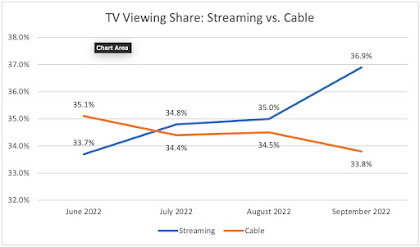Just-released video consumption numbers from Nielsen hammer home a point to which Free State Foundation scholars repeatedly return: streaming is the 800 lb. gorilla in a marketplace distorted by one-sided, outdated regulations that inappropriately hamstring cable operators and other traditional multichannel video programming distributors (MVPDs) – and thereby deny consumers the full benefits of competition.
In "A Tale of Two Trends: Traditional Video Distributors Shrink While Streaming Video Grows," a recent Perspectives from FSF Scholars, I drew a stark contrast between (1) the latest evidence of steady traditional MVPD subscriber losses, and (2) a watershed moment in the battle for eyeballs between streaming, broadcast television, and cable: in June 2022, streaming for the first time surpassed the one-third of total usage threshold.
Nielsen data covering the last three months underscores the zero-sum rivalry between the new and old guards. From June to September, streaming's share climbed an additional 3.2 percent, to 36.9 percent. Over the same period, cable's share fell 1.3 percent, to 33.8 percent. Critically, streaming's share surpassed that of cable in July – and, by September, that gap had grown to 3.1 percent.
The following chart illustrates these recent developments:
As Free State Foundation President Randolph May and Director of Policy Studies and Senior Fellow Seth Cooper argued persuasively in Reply Comments filed in GN Docket No. 22-203:
The legacy video regulatory landscape bears no resemblance to 2022's marketplace in which consumers increasingly favor a dynamic, self-curated mix of subscription streaming services accessed on consumer-owned devices over traditional MVPD services. Thus, the Commission should identify legacy regulation of MVPD services based originally on a lack of competition and eliminate, modify, or recommend congressional repeal of such regulation.




